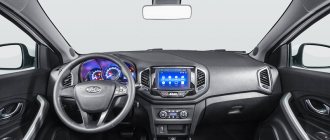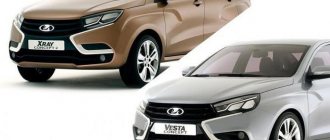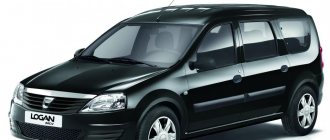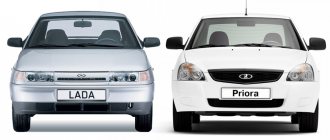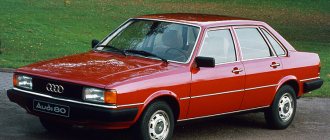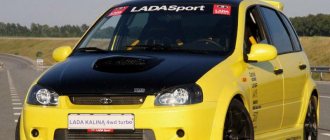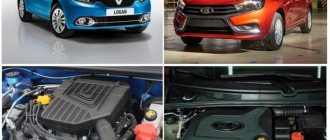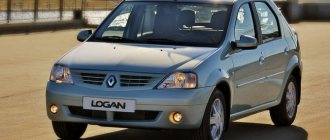November 15, 2017 Lada.Online 27 268 9
In November, sales of the raised Kia Rio X-Line hatchback began. Externally, this car can be compared with the Lada Vesta SW Cross and Lada XRAY. The starting price is on par with domestic cars, which makes the buyer think twice. Let's figure out whether these models can be called competitors.
Popularity and dimensions of vehicles
Korean cars from the Kia concern have been conquering the market for a long time. Like the Hyundai Solaris, the Kia Rio is one of the top sellers.
Nevertheless, the prestige of the Korean manufacturer is still at a fairly low level, not reaching such famous concerns as Volkswagen, Honda and Mercedes.
AvtoVAZ, on the contrary, has just entered the fight against foreign cars and is still far behind them. Domestic cars are seriously guilty of minor flaws and ill-conceived designs of running gear.
When choosing which is better: Lada X-Ray or Kia Rio, you should take into account the dimensions of the vehicles.
A car from a Korean manufacturer in a hatchback body has the following dimensions:
- length – 4,120 millimeters;
- width – 1,700 millimeters;
- height – 1,470 millimeters;
- weight – 1,120 kilograms.
The wheelbase of the Kia Rio is 2,570 millimeters, and the ground clearance is 160 millimeters. The luggage compartment volume with the seats up in the hatchback is 389 liters.
The domestic car can boast of the following weight and size parameters:
- length – 4,165 millimeters;
- width – 1,764 millimeters;
- height – 1,570 millimeters;
- weight – 1,190 kilograms.
The wheelbase of the Lada X-Ray is 2,592 millimeters, and the ground clearance is 195 millimeters. The trunk volume in the domestic crossover with the rear seats up is 361 liters.
According to the above data, we can conclude that the domestic car is significantly larger in size and has a significantly higher ground clearance. At the same time, the Korean vehicle is much smaller, but has a more capacious luggage compartment.
In general, it is difficult to determine which is better, since some people value compactness, while others want to drive a large car.
Power plants
When comparing the Kia Rio and Lada X-Ray, it’s worth saying a few words about the engines.
The Kia car comes with the following power plants:
- 4 liter petrol engine with 107 horsepower.
- 6 liter engine with 123 horsepower.
The first installation option is installed on budget versions of Korean cars. The 107-horsepower engine accelerates the vehicle to 100 kilometers in 11.6 seconds. The maximum speed is 185 kilometers per hour.
Special mention should be made of the very low fuel consumption, which when driving around the city does not exceed 8 liters per hundred kilometers.
The older model of the Rio car's power plant, complete with a 123-horsepower engine, is equal to 190 kilometers per hour. The increase in engine displacement had a slight effect on fuel consumption.
Gearboxes
The gearboxes used in vehicles will help you compare Lada x ray and Kia Rio.
The domestic vehicle has:
- Five-speed manual transmission. This type of gearbox is installed on both engine modifications.
- Five-speed robotic manual transmission. The decision to use a robot instead of an automatic machine is explained by the pursuit of making the car as cheap as possible.
The Kia car can be equipped with the following transmissions:
- Five-speed manual gearbox. This transmission option is used only for the younger 107-horsepower modification of the power unit.
- Four-speed automatic transmission. The junior automatic can only control a 1.4 liter engine.
- Six-speed manual transmission. The box comes only with a 123-horsepower engine.
- Six-speed automatic transmission. A modern automatic transmission is paired with an older version of the power plant.
It is thanks to the presence of a six-speed automatic that the Kia car confidently wins in the comparison of transmissions.
Prices and options
Content
The Lada XRay Cross 2021 model year is offered to customers in three versions: “Classic”, “Comfort” and “Luxe”, and the Kia Rio X-Line 2021 - in five: “Comfort”, “Luxe”, “Europa League”, “ Prestige" and "Premium". The price for the X-Ray Cross “Classic” starts at 754,900 rubles for a 1.8-liter engine (122 hp) and a 5-speed manual transmission, and the X-Line “Comfort” with a 1.4-liter engine (100 hp) and 6-speed manual transmission costs 884,900 rubles, that is, 130,000 rubles. (17%) more expensive. Both models are equipped with: front airbags, electronic stability control system ESC, emergency communication Era-Glonass and front electric windows. And Kia, unlike its competitor, is additionally equipped with: air conditioning, an audio system with steering wheel controls, side mirrors with electric drive and heating, rear electric windows, heated front seats and steering wheel. In general, X-Line is equipped with everything you need for your money, and X-Ray Cross offers a completely “empty” car, but with 17-inch alloy wheels (the counterpart has 15-inch steel ones).
The above comparison is incorrect due to the significant difference in the set of options and engine power. Therefore, let's compare similar modifications of the models. Lada X-Ray Cross 1.8 (122 hp) 5MT and Kia Rio X-Line 1.6 (123 hp) 6MT in the “Comfort” configuration of the same name are offered to customers for 834,900 rubles and 909,900 rubles, respectively . That is, a “Korean” costs 75,000 rubles. (9%) more expensive. In this version, the Russian car first catches up with its opponent in terms of the list of options (with the exception of a heated steering wheel), and then overtakes due to the presence of: a drive mode selector (“Sport”, “Snow”, “Sand”), front fog lights and rear parking sensors
Now let's compare the basic versions with automatic transmissions. And here the biggest surprise awaits us. Lada XRay Cross 2021 can only be equipped with a manual transmission! It is difficult to understand such a marketing ploy, but we can only accept it. But the Kia Rio X-Line 2021 can be equipped with an automatic transmission connected to any of its engines. The minimum price for two pedals is 924,900 rubles for a modification with a 1.4-liter engine (100 hp) in the same “Comfort” configuration, that is, the additional payment for a 6-speed automatic transmission was 39,100 rubles.
To finish talking about prices, let's compare the top versions. Lada X-Ray Cross 1.8 (122 hp) 5MT “Luxe” with the “Prestige” package costs 913,900 rubles, and Kia Rio X-Line 1.6 (123 hp) 6MT “Europa League” — 967,900 rubles, that is, 54,000 rubles. (6%) more expensive. For this money, the cars received climate control, a rear view camera and a 7-inch multimedia screen. But despite the lower price, the X-Ray Cross is also equipped with: cruise control, navigation and heated rear seats. However, in this comparison, only the Lada has a top-end configuration, for which we have selected a comparable version of the opponent. The truly maximum version of the Korean model is the X-Line 1.6 (123 hp) “Premium” with a 6-speed automatic transmission for 1,134,900 rubles. This car has options in its equipment list that its competitor does not have, namely: side airbags and curtain airbags, heated windshield and heated injectors, as well as Android Auto and Apple Car Play integration.
Car suspension
Structurally, car suspensions are no different. In both cars, the rear suspension is represented by a semi-independent torsion beam, and the front suspension is represented by MacPherson struts.
When driving a Rio car on a flat road, the suspension works well against minor defects in the asphalt surface. When driving into rough terrain, all shocks begin to be transmitted to the steering wheel and make it difficult to control the vehicle.
In other words, driving the Kia Rio on rough terrain is problematic due to insufficient energy consumption and smoothness.
The behavior of a domestic car is completely different. Thanks to the well-designed suspension, the Lada X-Ray calmly passes through areas of any complexity and practically does not feel minor irregularities. However, due to the significant ground clearance, the Lada exhibits roll when cornering.
The cross-country ability of the X-Ray car is beyond praise. Thanks to the high ground clearance, the car can easily climb small obstacles, and the ESC system allows you to drive to heights unprecedented for Kia.
In terms of suspension, in a comparison of Kia and Lada X Ray, the domestic car wins a landslide victory.
Specifications
In terms of technical characteristics, the rivals are approximately equal, although in certain aspects it is immediately clear that one of them wins. This means that if you really need to identify the winner in the battle between Lada X Ray vs KIA Rio, you should clearly define your requirements.
Engines
In this case, you can put an equal sign. Both the Russian and Korean hatchbacks have a pair of gasoline engines, which are very similar in their performance. A characteristic difference between the engines is the larger displacement of X-Ray, with generally the same power.
The basic version of LADA XRAY is offered with a 1.6-liter aspirated in-line engine. This engine was developed at VAZ, and the VAZ-21129 type was chosen as the basis for it. As a result, the designers managed to achieve a power of 106 hp. With. at around 6300 rpm, supplementing it with a thrust of 148 Nm at 4200 rpm.
All this made it possible to guarantee the model good dynamics of 11.4 seconds. up to hundreds, as well as a peak acceleration of 174 km/h. At the same time, they also maintained acceptable consumption, which in city traffic is only a little more than 9 liters.
1.6 liter X Ray engine
On the KIA Rio side there is the same 16-valve aspirated engine, but with a volume of 1.4 liters. However, the smaller cubic capacity did not affect its performance in any way - 170 hp. With. this unit produces at 6300 rpm, while the torque is at 5,000 rpm. equal to 135 Nm.
The dynamics, despite the lower traction, are almost the same - 11.6 seconds, but the maximum speed is 11 km/h higher - 185 km/h. But the main thing is that gasoline consumption is significantly lower, which in the city is 7.6 liters.
Rio with a 1.4-liter engine
At the top, X-Ray offers a new 1.8-liter engine of its own design. However, the main innovation lies precisely in the increase in working volume. Otherwise, this is a regular in-line injection engine. However, the increase in cubic capacity had a beneficial effect on the output, which increased to 122 hp. With. at 6900 rpm And the moment rose to 170 “newtons”.
This unit guaranteed an improvement in acceleration dynamics to 10.4 seconds, as well as an increase in the speed limit to 185 km/h. And the consumption did not increase, remaining at the same 9.3 liters. per hundred.
X Ray with 1.8 l engine
KIA Rio meets it with a 1.6-liter engine with a capacity of 123 hp. s., which the driver receives at 6300 rpm. But in terms of torque, the Korean model is significantly inferior - only 155 Nm at 4200 rpm. However, the dynamics are the same as those of the competitor - 10.3 seconds, at a maximum speed of 190 km/h. Appetite fluctuates around 8.5 liters.
The 1.6-liter KIA engine is not inferior in power to the 1.8-liter Lada
As you can see, in many ways the motors are equal. Yes, LADA has a larger volume and, thanks to this, more torque. However, KIA responds with lower fuel consumption, which is extremely important in the current realities. Therefore, in the rivalry between X Ray and Rio, the chances are approximately equal.
Transmissions
In terms of gearboxes, the KIA Rio is better than the Lada X-Ray, which is simply worth admitting. This is due to both a wider selection and the presence of a classic automatic machine, but with some reservations.
Both engines of the Russian hatchback can be paired with a 5-speed manual transmission developed in France.
Manual 5 X Ray
The Korean model also has a 5-speed manual transmission, but it is intended only for 1.4-liter modifications.
MT5 Rio
Cars with a 1.6 liter engine are equipped with a manual transmission6, which largely explains the efficiency of the car.
And this is already a 6-speed manual transmission
For fans of 2-pedal versions, the XRAY can be purchased with a 5-band AMT. This is a robotic transmission created from the MT 21826 box. The decision to use a robot rather than an automatic transmission allowed VAZ to reduce the price of the hatchback as much as possible.
5-band robot AMT
KIA took a different route and chose a classic automatic transmission. For 1.4-liter versions, only 4-band AT is available. Although this is normal for class B, I still want more modern solutions.
4-speed automatic transmission
And they are offered with a 1.6 liter engine. It is equipped with a 6-speed automatic transmission, which gives the Korean a decisive advantage.
Modern 6-speed automatic
Chassis
The suspension of both models is structurally the same. No one has a multi-link design - only a semi-independent layout, with a torsion beam on the rear axle and MacPherson struts at the front. There is no all-wheel drive either.
But the handling of competitors is different. KIA Rio performs well on a flat road, without serious defects or damage. And the point is not so much that on such a road you can “pick up” breakdowns in the struts, but rather the nervousness of the steering. When driving on uneven roads, shocks are transmitted to the hatchback's steering wheel, making it difficult to control. The result is that the Rio suspension lacks energy intensity and smoothness.
Kia Rio chassis with torsion beam
X Ray's character is different. The suspension of this model, based on the Renault Sandero Stepway, flaunts its energy intensity - even large potholes are perceived calmly on the Russian model, and small irregularities may not be noticed at all. On the other hand, serious ground clearance and height result in greater rolls in corners than their counterparts.
X-Ray chassis
Regarding cross-country ability, the Lada X-Ray is better than the KIA Rio, and much better! The ground clearance of the hatchback will do honor to some crossovers, and the switchable ESC system allows you to confidently climb into such wilds where the Rio is completely barred. Of course, this electronics will not replace all-wheel drive, however, even without a 4x4 layout, the off-road advantage over the Korean is simply overwhelming!
X-Ray's ground clearance of 195 mm often helps out
The off-road capabilities of the LADA XRAY with switchable ESC are clearly demonstrated in the Ladnaya Mechanics video.
Options and prices
The Lada X-ray car is sold in three trim levels:
- Optima. The cost of this configuration on the Russian market starts from 600,00 rubles.
- Luxury A car version with a luxury set of devices will cost at least 710,000 rubles.
- Exclusive. The maximum version of the Lada XRay car will empty your wallet in the amount of 806,000 rubles.
The Korean car has six trim levels:
- Comfort. The cost of such a car starts from 640,000 rubles.
- Audio comfort. An additional purchase of a radio will cost 40 thousand.
- Luxury The cost for this version of the car starts from 710,000 rubles.
- Prestige. This version will cost the buyer at least 776,000 rubles.
- Premium The maximum configuration costs from 876,000.
- Premium NaVi. This version of the car costs from 903,000 rubles.
Chery Tiggo 4 vs Kia Rio X-Line and Lada XRAY Cross
Today in Russia there is a huge selection of crossovers. Among them, the urban crossover segment plays a special role. This class of cars accounts for the greatest demand. After all, they are compact, the price is reasonable, but they have a higher seating position compared to regular C class sedans.
You can’t count on good cross-country ability, but the ground clearance even for city crossovers is very good. This year, two new cars debuted on the Russian market: Lada XRAY Cross, Chery Tiggo 4. And these two cars can be compared with the Kia X-Line. What to choose: a full-fledged city crossover or a hatchback with increased ground clearance and a plastic body kit?
Chery Tiggo 4. This car is clearly worth the money. It has an attractive design and rich equipment. This time the Chinese crossover looks very nice. The appearance of the car is distinguished by double-decker LED optics, chrome trim and a large radiator grille. The interior of the Tiggo 4 is even better.
There is a digital dashboard, a multimedia system with gesture control, and much more. The most important thing is that the multimedia center really works smoothly, and using gestures you can change the radio station or adjust the volume.
A digital dashboard is still the prerogative of expensive and high-status cars. But this option is available even in the basic version of this crossover. True, the number of functions of this dashboard is minimal.
The most popular engine is a two-liter naturally aspirated unit with a power of 122 hp. and a variator. Well, the combination is quite non-standard, but the car drives and handles at a good level. Overall, this Chinese crossover is definitely worth the money.
Kia Rio X-Line. This car appeared back in 2018. And immediately its sales started at a rapid pace. However, this car is not an independent model. Essentially this is the same Rio, but with ground clearance increased to 195 mm. And the seating position of this car is actually higher than that of the standard model. You could even say that this is a Rio with a hatchback body. But there are also advantages. Firstly, the car has an attractive design and ground clearance. And secondly, it has a proven 1.6-liter engine with a power of 123 hp. and a classic automatic.
Lada XRAY Cross. This hatchback with increased ground clearance and a beautiful off-road body kit is built on the proven B0 platform. The engine here also has a volume of 1.6 liters and a power of 113 hp. A variator is installed as a transmission. Overall the car is very bright and beautiful, but the dynamics are disappointing. It’s good that you can now buy this car with a CVT, because previously you could only choose a robotic gearbox.
Bottom line. All three cars have a striking design.
But there is only one crossover - Chery Tiggo 4. And I must say that this is the best car in the test. But it is also the most expensive, the price starts from 1,029,000 rubles. And Lada XRAY Cross and Kia X-Line cost 846,900 and 954,900 rubles, respectively.

